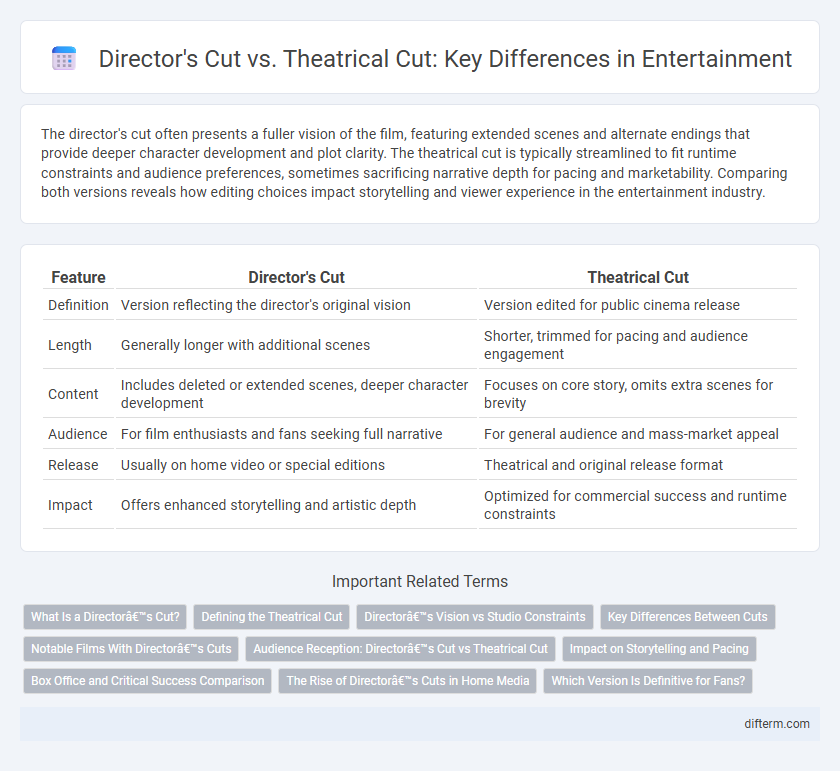The director's cut often presents a fuller vision of the film, featuring extended scenes and alternate endings that provide deeper character development and plot clarity. The theatrical cut is typically streamlined to fit runtime constraints and audience preferences, sometimes sacrificing narrative depth for pacing and marketability. Comparing both versions reveals how editing choices impact storytelling and viewer experience in the entertainment industry.
Table of Comparison
| Feature | Director's Cut | Theatrical Cut |
|---|---|---|
| Definition | Version reflecting the director's original vision | Version edited for public cinema release |
| Length | Generally longer with additional scenes | Shorter, trimmed for pacing and audience engagement |
| Content | Includes deleted or extended scenes, deeper character development | Focuses on core story, omits extra scenes for brevity |
| Audience | For film enthusiasts and fans seeking full narrative | For general audience and mass-market appeal |
| Release | Usually on home video or special editions | Theatrical and original release format |
| Impact | Offers enhanced storytelling and artistic depth | Optimized for commercial success and runtime constraints |
What Is a Director’s Cut?
A director's cut is a version of a film that reflects the director's original vision, often including scenes or edits removed from the theatrical release. It provides a fuller narrative experience, showcasing extended footage, alternative scenes, or changes in pacing that enhance storytelling and character development. This version is highly valued by cinephiles and critics for offering deeper insight into the director's creative intent.
Defining the Theatrical Cut
The theatrical cut of a film is the version released in cinemas, typically edited to meet runtime constraints, pacing, and audience appeal for a broad demographic. It reflects the collaborative decisions made by directors, producers, and studios to optimize commercial success and narrative clarity within standard viewing formats. This cut often excludes extended scenes, alternate endings, or creative content preserved for director's cuts or special editions.
Director’s Vision vs Studio Constraints
The director's cut offers a purer representation of the filmmaker's original vision, often restoring scenes and narrative elements altered or removed due to studio constraints such as runtime limits, content restrictions, or market considerations. These versions enable audiences to experience the intended tone, pacing, and character development that studios might have compromised for broader appeal or commercial viability. Examining the differences highlights the ongoing tension between artistic expression and industry demands within the entertainment landscape.
Key Differences Between Cuts
Director's cuts often reveal the filmmaker's original vision by including extended scenes, alternate endings, and enhanced character development that were omitted or altered in theatrical cuts. Theatrical cuts prioritize pacing and audience appeal for cinema release, sometimes sacrificing narrative depth or subplots for runtime constraints. Differences in sound design, visual effects, and editing style further distinguish the director's cut, offering a more immersive and authentic storytelling experience.
Notable Films With Director’s Cuts
Notable films with director's cuts include Ridley Scott's "Blade Runner," which offers a darker, more complex vision than the theatrical release, and George Lucas's "Star Wars: Episode IV - A New Hope," featuring added scenes and enhanced effects. The director's cut of "Apocalypse Now" by Francis Ford Coppola restores deleted sequences, providing deeper character development and narrative clarity. These versions often appeal to cinephiles seeking the filmmaker's original intent and expanded story elements.
Audience Reception: Director’s Cut vs Theatrical Cut
Audience reception often varies between the director's cut and the theatrical cut, with the director's cut typically appealing to cinephiles and dedicated fans seeking a more complete or original vision. Theatrical cuts generally receive broader acceptance due to their tighter pacing and commercial appeal, aligning with mainstream viewer preferences. Critical responses also differ, as director's cuts may highlight artistic intent while theatrical versions focus on accessibility and narrative clarity.
Impact on Storytelling and Pacing
The director's cut often restores scenes that enhance character development and narrative depth, allowing for a richer storytelling experience compared to the theatrical cut, which is typically edited for time and commercial appeal. Pacing can significantly differ as the director's cut may include extended sequences that slow the narrative for thematic emphasis, while the theatrical cut prioritizes a faster pace to maintain audience engagement. These variations impact audience perception and emotional connection, with director's cuts offering a more immersive and nuanced interpretation of the film's story.
Box Office and Critical Success Comparison
Director's cuts often provide a more authentic vision, which can enhance critical acclaim but may not always translate to higher box office revenue compared to theatrical cuts. Theatrical cuts are typically designed for broader audience appeal and marketability, often resulting in stronger initial box office performance. Films like Ridley Scott's "Blade Runner" demonstrate how director's cuts can achieve lasting critical success and cult status despite modest theatrical returns.
The Rise of Director’s Cuts in Home Media
Director's cuts have surged in popularity within home media, offering audiences extended or altered versions of theatrical releases that provide deeper narrative insights and more creative control from filmmakers. These editions often include restored scenes, improved special effects, and director commentary, enriching the viewing experience beyond what was initially screened in theaters. Streaming platforms and Blu-ray releases have accelerated this trend by making exclusive director's cuts more accessible to film enthusiasts worldwide.
Which Version Is Definitive for Fans?
Director's cuts often provide a more authentic vision of a film, featuring extended scenes, improved character development, and narrative depth that fans crave. The theatrical cut, while more widely seen, is usually edited for pacing and commercial appeal, sometimes sacrificing artistic intent. For dedicated fans, the director's cut is frequently considered the definitive version as it aligns closely with the creator's original storytelling.
director’s cut vs theatrical cut Infographic

 difterm.com
difterm.com